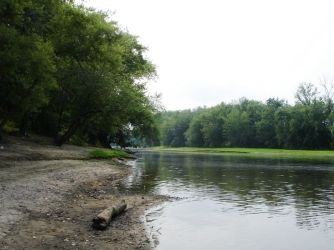By David M. Powers

Mouth of the Agawam (Westfield) River
The original pioneers in Springfield took a weekend in mid-May, 1636, to frame the shape of their settlement. In typical Puritan fashion they entered a covenant together, a written agreement to create a new community. Their basic constitution, composed on Saturday, May 14, listed thirteen “articles and orders.” The initial article acknowledged the bedrock requirement for any Puritan settlement:
“We intend by God’s grace as soon as we can with all convenient speed to procure some Godly and faithful minister with whom we purpose to Join in Church Covenant . . .”
Other articles exhibit a Puritan core value, the “principle of equity.” (David D. Hall, “A Reforming People”). Everyone was supposed to be treated right. Real estate taxes were to be levied proportionally, “aker for aker”; in fact all was to be done “accordinge to every ones proportion.” All recruits to Springfield would share in bearing the costs of creating it, including the price of boats which were needed for moving to the Valley, and a £6 expense for the original Agawam “House Meadow” shelter. Any trees cut for timber and left on the ground for more than 3 months would be fair game for anyone.

William Pynchon (engraving by Louis Orr, 1927)
The founders limited the new settlement to 40 families, or 50 at the most, both rich and poor. Each would have a house lot in “convenient proportion . . . for everyones quality and estate.” All would have shares in pasture, meadow, and planting lands on the west side of the river and to the north and south of the town. House lots would be laid out along a primitive Main Street. Everybody would also receive a portion of the low-lying marshlands which ran along the eastern side of this street.
After a break on Sunday, on Monday, May 16, the settlers added a rudimentary scheme for dividing property. They also decided on generous minimum sizes for homestead lots. All eight of what William Pynchon called the “first subscribers & adventurers for the plantation” signed, two by making their marks.
________________________________________
Read more in “Damnable Heresy: William Pynchon, the Indians, and the First Book Banned (and Burned) in Boston.”
